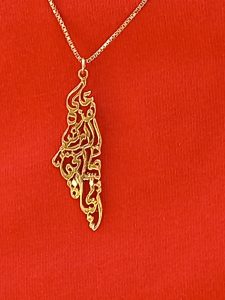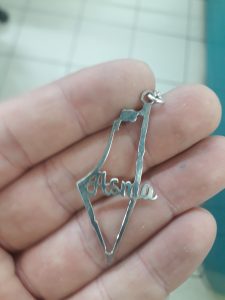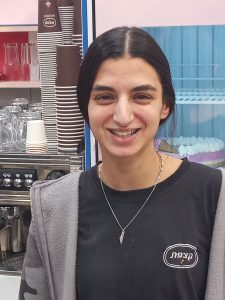Hilik Wald’s Monthly Newsletter January 2025: Accessories and Jewels in a cultural context
It is not uncommon for people to wear jewelry or darn fashion with a political statement. From the yellow bracelet, or pin for the return of the hostages to the dresses with the flag of Israel or Palestine at the most glittering events in the USA. At the Eurovision song competition held in Sweden in April 2024, the representative of Israel, Eden Golan, wore a top that looked like bandages or ligatures. Her stylist explained that he wanted materials which could naturally express Israeli society’s feelings of grief, wounds and cuts post October 7th.
The pendant shaped like Israel from both sides of the Jordanian river, has an interesting narrative, because it is used in the same way by two sides that are in a territorial and identity struggle (Israel and Palestinian).
The shape of Israel itself also underwent a change following the events of October 7, from a shape identified mainly with the right political sector, it has now come to reflect the feelings of many Israelis – Israel as a whole including Judea and Samaria which have always been under political speculation.
To me, being a tour guide means more than just showcasing my country, I get the opportunity to act as a cultural mediator. My guests and I look at the reality and I try to explain what we see, why it is how it is and the cultural context.
The pendant describes the Land of Israel, Ancient Palestine or in neutral language the geographical area between the Mediterranean Sea and the Jordan River. Below are three examples of the Palestinian pendant. Please note that usually in the Palestinian pendant, the Dead Sea and Sea of Galilee are not shown. The Golan Heights is not a part either, because it was captured by Israel from Syria in the 1967 war and therefore should be returned to Syria, just as all the lands in Palestine which were conquered in 1948 after the Arab states declared war and lost.
Other means of identifying that this is a Palestinian pendant is an Arabic inscription inside the pendant; the Arab name Asma, and that the entire area between the sea and the river belongs to the same territory. This is the central Palestinian narrative: from the river to the sea. When I see someone walking with the pendant on the street, I approach and ask him to take a picture of the pendant. As in the United States, politics is a sensitive subject. I don’t need to ask the Palestinians what they mean. It is quite clear what their intentions may be, however for other cultures to wear the pendant has significant political impact.
Please note that usually, the Palestinian people photographed do not feel comfortable being photographed with their faces visible, out of fear that I am a Mossad agent and then they will get into trouble with the state.
It is important to note that most of the photographs are from Jerusalem, whose legal status is residents and not citizens (East Jerusalemites). Among the Arabs of the State of Israel, we will find the pendant, but in smaller quantities. The Arabs Israelis are even more sensitive about their belonging to Israel and how the Jewish majority sees them.
For the Jews of Israel, things are on the one hand clearer and more convenient and on the other hand more complex: before the seventh of October 2023, this pendant marked the wearer’s affiliation with the right-wing camp that believes that the entire Land of Israel should be under Israeli control. The reasons for this are divided into two: the religious believe in God’s promise to Abraham to give him the land of Canaan and the secular believe that we must not give up parts of the Land of Israel for security purposes. It is important to note that Jews usually have no problem sharing their political views. With the Jews, I have to ask what they mean: right-wing politics or not.
The Jewish-Israeli pendant will be identified by the Star of David (as in the photo of the smiling man), the appearance of the Dead Sea, the Sea of Galilee and the Golan Heights. In most cases the Jewish-Israeli pendant is hollow inside, but I have also seen it as if it were filled between the sea and the river.
After the October 7th masacre, I found that many who wear this pendant do not necessarily identify themselves as political right-wing voters. They explain that the pendant represents to them Israel as their home and place of belonging.
After the murderous attack on Israeli citizens in the Gaza border area, many felt that their physical existence in the country was in danger and wearing the pendant is a statement that refers to that feeling. Before the attack, I couldn’t find anyone who would wear this pendant and wanted to share that they voted for the left wing.
After the seventh of October, many said they were in the political center and some (not many) belonged to the political left camp.
So, one pendant has at least three different paths. Perhaps the State of Israel really is a description of the Jewish joke: two Jews, three opinions.
The first two photos from the left are Arabs, and the last two from the left are Jewish.




I’m looking forward to hearing your thoughts and will be back with more insights on Israel next month. Hilik
“How good and pleasant it is when brothers (and sisters) live together in unity!”, Psalms, 133, 1.
Liri, Daniela, Naama and Karina, Home at last.
